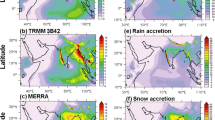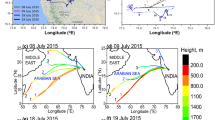Abstract
Influence of the environmental thermodynamics on the microphysics of deep cumulus clouds over different parts of India is studied using in situ airborne observations from the Cloud Aerosol Interaction and Precipitation Enhancement EXperiment (CAIPEEX) during 2009. This study provides an understanding of the thermodynamics–microphysics relation over the Indian summer-monsoon region. Relatively stronger updraft and turbulence are noted in the pre-monsoon cloud base layers compared to that of the monsoon clouds. It is illustrated from the in situ observations as well as from a microphysical parcel model that the vertical variation of cloud droplet number concentration (CDNC) has a well-defined peak at a certain height above the cloud base. This elevated CDNC peak is found to be connected with the cloud parcel buoyancy and cumulative convective available potential energy (cCAPE). Higher parcel buoyancy above the cloud base of dry pre-monsoon clouds is associated with stronger in-cloud updraft velocity, higher supersaturation and higher droplet number concentration (in addition to aerosol effect). Higher adiabatic fraction and lower entrainment rate are observed in polluted clouds where boundary layer moisture is low, compared to clean clouds. Relative dispersion of droplet size distribution is found to vary concurrently with air mass characteristics and aerosol number concentration observed over different locations during the experiment. Aerosol–precipitation relationships are also investigated from the observation. Maximum reflectivity and rain rates showed a direct link with boundary layer water vapor content rather than with subcloud aerosol number concentration.











Similar content being viewed by others
References
Ackerman, A. S., Kirkpatrick, K. P., Stevens, D. E., & Toon, O. B. (2004). The impact of humidity above stratiform clouds on indirect aerosol climate forcing. Nature, 432, 1014–1017. https://doi.org/10.1038/nature03174.
Albrecht, B. (1989). Aerosols, cloud microphysics, and fractional cloudiness. Science, 245, 1227–1230. https://doi.org/10.1126/science.245.4923.1227.
Andrea, M. O., Rosenfeld, D., Artaxo, P., Costa, A. A., Frank, G. P., Longo, K. M., et al. (2004). Smoking rain clouds over Amazon. Science, 303, 1337–1342.
Bera, S., Pandithurai, G., & Prabha, T. V. (2016a). Entrainment and droplet spectral characteristics in convective clouds during transition to monsoon. Atmospheric Science Letters, 17, 286–293. https://doi.org/10.1002/asl.657.
Bera, S., Prabha, T. V., & Grabowski, W. W. (2016b). Observations of monsoon convective cloud microphysics over India and role of entrainment-mixing. Journal of Geophysical Research: Atmospheres, 121, 9767–9788. https://doi.org/10.1002/2016jd025133.
Blyth, A., Cooper, W. A., & Jensen, J. B. (1988). A study of the source of entrained air in Montana cumuli. Journal of Atmospheric Science, 45, 3944–3964. https://doi.org/10.1175/1520-0469(1988)045<3944:ASOTSO>2.0.CO;2.
Böing, S. J., Jonker, H. J. J., Nawara, W. A., & Siebesma, A. P. (2014). On the deceiving aspects of mixing diagrams of deep cumulus convection. Journal of the Atmospheric Sciences, 71, 56–68.
Derksen, J. W. B., Roelofs, G.-J. H., & Rockmann, T. (2009). Influence of entrainment of CCN on microphysical properties of warm cumulus. Atmospheric Chemistry and Physics, 9, 6005–6015.
Fan, J., Rosenfeld, D., Zhang, Y., Giangrande, S. E., Li, Z., Machado, L. A. T., et al. (2018). Substantial convection and precipitation enhancements by ultrafine aerosol particles. Science, 359(6374), 411–418. https://doi.org/10.1126/science.aan8461.
Gayatri, K., Patade, S., & Prabha, T. V. (2017). Aerosol–Cloud interaction in deep convective clouds over the Indian Peninsula using spectral (bin) microphysics. Journal of Atmospheric Sciences, 74, 3145–3166. https://doi.org/10.1175/jas-d-17-0034.1.
Gerber, H., Frick, G., Jensen, J., & Hudson, J. (2008). Entrainment, mixing, and microphysics in trade-wind cumulus. Journal of the Meteorological Society of Japan, 86A, 87–106.
Jensen, J. B., Austin, P. H., Baker, M. B., & Blyth, A. M. (1985). Turbulent mixing, spectral evolution and dynamics in a warm cumulus cloud. Journal of the Atmospheric Sciences, 42, 173–192.
Jensen, J. B., & Baker, M. B. (1989). A simple model of droplet spectral evolution during turbulent mixing. Journal of the Atmospheric Sciences, 46, 2812–2829.
Khain, A. P. (2009). Notes on state-of-the-art investigations of aerosol effects on precipitation: A critical review. Environmental Research Letters, 4, 015004. https://doi.org/10.1088/1748-9326/4/1/015004.
Khain, A. P., Roseenfeld, D., & Pokrovsky, A. (2005). Aerosol impact on the dynamics and microphysics of deep convective clouds. Quarterly Journal of the Royal Meteorological Society, 131, 2639–2663. https://doi.org/10.1256/qj.04.62.
Konwar, M., Maheskumar, R. S., Kulkarni, J. R., Freud, E., Goswami, B. N., & Rosenfeld, D. (2012). Aerosol control on depth of warm rain in convective clouds. Journal of Geophysical Research: Atmospheres, 117, D13204. https://doi.org/10.1029/2012jd017585.
Konwar, M., Panicker, A. S., Axisa, D., & Prabha, T. V. (2015). Near-cloud aerosols in monsoon environment and its impact on radiative forcing. Journal of Geophysical Research, 120, 1445–1457.
Kucieńska, B., Montero-Martínez, G., & García-García, F. (2010). A simulation of the influence of organic and inorganic pollutants on the formation and development of warm clouds over Mexico City. Atmospheric Research, 95, 487–495.
Kulkarni, J. R., Maheshkumar, R. S., Morwal, S. B., Padma kumara, B., Konwar, M., Deshpade, C. G., et al. (2012). Cloud aerosol interaction and precipitation enhancement experiment (CAIPEEX): overview and preliminary results. Current Science, 102, 413–425.
Li, Z., Niu, F., Fan, J., Liu, Y., Rosenfeld, D., & Ding, Y. (2011). Long-term impacts of aerosols on the vertical development of clouds and precipitation. Nature Geoscience, 4, 888–894.
Lu, M. L., Feingold, G., Jonsson, H. H., Chuang, P. Y., Gates, H., Flagan, R. C., et al. (2008). Aerosol–cloud relationship in continental shallow clouds. Journal of Geophysical Research: Atmospheres, 113, D15201. https://doi.org/10.1029/2007JD009354.
Lu, C., Liu, Y., Yum, S. S., Niu, S., & Endo, S. (2012). A new approach for estimating entrainment rate in cumulus clouds. Geophysical Research Letters, 39, L04802.
Mechem, D. B., Yuter, S. E., & de Szoeke, S. P. (2012). Thermo-dynamic and aerosol controls in southeast Pacific stratocumulus. Journal of Atmospheric Science, 69, 1250–1266. https://doi.org/10.1175/jas-d-11-0165.1.
Miles, N. L., Verlinde, J., & Clothiaux, E. E. (2000). Cloud droplet size distributions in lowlevel stratiform clouds. Journal of Atmospheric Science, 57, 295–311.
Morrison, H., & Grabowski, W. W. (2007). Comparison of bulk and binwarm-rain microphysics models using a kinematic framework. Journal of the Atmospheric Sciences, 64, 2839–2861.
Murugavel, P., Malap, N., Balaji, B., Mehajan, R. K., & Prabha, T. V. (2017). Precipitable water as a predictor of LCL height. Theoretical and Applied Climatology, 130, 467.
Nair, S., Sanjay, J., Pandithurai, G., Maheskumar, R. S., & Kulkarni, J. R. (2012). On the parameterization of cloud droplet effective radius using CAIPEEX aircraft observations for warm clouds in India. Atmospheric Research, 108, 104–114. https://doi.org/10.1016/j.atmosres.2012.02.002.
Paluch, I. R. (1979). The entrainment mechanism in Colorado cumuli. Journal of Atmospheric Science, 36, 2467–2478.
Pandithurai, G., Dipu, S., Prabha, T. V., Maheshkumar, R. S., Kulkarni, J. R., & Goswami, B. N. (2012). Aerosol effect on droplet spectral dispersion in warm continental cumuli. Journal of Geophysical Research: Atmospheres, 117(1–15), D16202. https://doi.org/10.1029/2011jd016532.
Patade, S., Prabha, T. V., Axisa, D., Gayatri, K., & Heymsfield, A. (2015). Particle size distribution properties in mixed-phase monsoon clouds from in situ measurements during CAIPEEX. Journal of Geophysical Research: Atmospheres, 120, 10418–10440.
Patade, S., Shete, S., Malap, N., Kulkarni, G., & Prabha, T. V. (2016). Observational and simulated cloud microphysical features of rain formation in the mixed phase clouds observed during CAIPEEX. Atmospheric Research, 169, 32–45.
Prabha, T. V., Khain, A., Maheshkumar, R. S., Pandithurai, G., Kulkarni, J. R., Konwar, M., et al. (2011). Microphysics of pre-monsoon and monsoon clouds as seen from in situ measurements during CAIPEEX. Journal of Atmospheric Science, 68, 1882–1901.
Prabha, T. V., Patade, S., Pandithurai, G., Khain, A., Axisa, D., Pradeep-Kumar, P., et al. (2012). Spectral width of premonsoon and monsoon clouds over Indo-Gangetic valley. Journal of Geophysical Research, 117, D20205. https://doi.org/10.1029/2011jd016837.
Raga, G. R., Jensen, J. B., & Baker, M. B. (1990). Characteristics of cumulus band clouds off the coast of Hawaii. Journal of Atmospheric Science, 47, 338–356.
Rangno, A. L., & Hobbs, P. V. (2005). Microstructures and precipitation development in cumulus and small cumulonimbus clouds over the warm pool of the tropical Pacific Ocean. Quarterly Journal of the Royal Meteorological Society, 131, 639–673.
Rosenfeld, D., Lohmann, U., Raga, G. B., O’Dowd, C. D., Kulmala, M., Fuzzi, S., et al. (2008). Flood or drought: How do aerosols affect precipitation? Science, 321(5894), 1309–1313.
Siebesma, A. P., et al. (2003). A large-eddy simulation intercomparison study of shallow cumulus convection. Journal of the Atmospheric Sciences, 60, 1202–1219.
Thomas, L., Malap, N., Grabowski, W. W., Dani, K., & Prabhakran, T. V. (2018). Convective environment in pre-monsoon and monsoon conditions over the Indian subcontinent: the impact of surface forcing. Atmospheric Chemistry and Physics Discussions. https://doi.org/10.5194/acp-2018-1.
Tölle, M. H., & Krueger, S. K. (2014). Effects of entrainment and mixing on droplet size distributions in warm cumulus clouds. Journal of Advances in Modeling Earth Systems, 6, 281–299. https://doi.org/10.1002/2012ms000209.
Twomey, S. (1977). The influence of the pollution in the shortwave albedo of clouds. Journal of the Atmospheric Sciences, 34, 1149–1152. https://doi.org/10.1175/1520-0469(1977)034<1149:TIOPOT>2.0.CO;2.
Wang, S., Wang, Q., & Feingold, G. (2003). Turbulence, condensation, and liquid water transport in numerically simulated non-precipitating stratocumulus clouds. Journal of the Atmospheric Sciences, 60, 262–278. https://doi.org/10.1175/1520-0469(2003)060<0262:tcalwt>2.0.co;2.
Warner, J. (1969). The microstructure of cumulus cloud. Part I. General features of the droplet spectrum. Journal of the Atmospheric Sciences, 26, 1049–1059.
Warren, S. G., Hahn, C. J., London, J., Chervine, R. M., & Jenne, R. L. (1986). Global distribution of total cloud cover and cloud type amounts over land. NCAR Tech. Note NCAR/TN-273 + STR, 29 pp.
Xue, H., & Feingold, G. (2006). Large-eddy simulations of trade wind cumuli: Investigation of aerosol indirect effects. Journal of the Atmospheric Sciences, 63, 1605–1622. https://doi.org/10.1175/jas3706.1.
Acknowledgements
The CAIPEEX project and IITM are fully funded by Ministry of Earth Sciences, Government of India, New Delhi.
Author information
Authors and Affiliations
Corresponding author
Rights and permissions
About this article
Cite this article
Bera, S., Prabha, T.V., Malap, N. et al. Thermodynamics and Microphysics Relation During CAIPEEX-I. Pure Appl. Geophys. 176, 371–388 (2019). https://doi.org/10.1007/s00024-018-1942-6
Received:
Revised:
Accepted:
Published:
Issue Date:
DOI: https://doi.org/10.1007/s00024-018-1942-6




